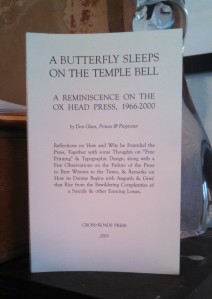
“A Butterfly Sleeps on the Temple Bell: A Reminiscence on the Ox Head Press, 1966-2000” by Don Olsen, Printer & Proprieter
Recently, SMSU English professor and Rural Lit RALLY Advisory Board member David Pichaske was kind enough to send me a copy of Don Olsen’s A Butterfly Sleeps on the Temple Bell: A Reminiscence on the Ox Head Press, 1966-2000 (Cross+Roads Press, 2003, 124pgs). Unfortunately, it’s out of print but I wanted to say a few words about it since, sadly, nowadays if it can’t be found with a Google Search, it doesn’t exist. Consider this short review my way of contributing to the western Minnesota paper trail.
Don Olsen was a letterpress printer who, prior to retiring in the late-’80s, was a librarian at Southwest Minnesota State University. It was during time that he founded Ox Head Press. In addition to printing cards and broadsides, Olsen published several small pamphlets by an impressive list of writers including Robert Bly, Bill Holm, Ursula K. Le Guin, Pablo Neruda, and Stephen Dunn. Many of these can only be found in university archives (in fact, a Google search for “Ox Head Press” only returns archive catalogs). As the book unfolds, so too does his printer’s philosophy, which incidentally was opposed to exactly what’s happened to his pieces.
Early on, I decided that I wanted Ox Head publications to be something that would be accessible to those of modest means. … I could produce “fine printing,” but instead of going fancy, I would rely on standard book papers. I would settle for “nice” printing.
Most of what is called “fine printing” goes into the private libraries of collectors or into the rare book rooms of libraries and museums where few people ever will hold the book in their hands. There is a kind of snobbery to this kind of work. Nevertheless, “fine printing” understandably is the standard by which typography and printing is judged. (p.39)
Still, this didn’t stop the Library of Congress or art museums from collecting copies of his more satirical pamphlets the moment they were bound. Of these, his parodynthology of William Carlos Williams is especially clever, and I hope someone with a rare copy digitizes it. It’s about time many of these pieces of literary “ephemera” were made more accessible.
The major weakness of A Butterfly Sleeps is that Olsen appears indecisive as to whether his book is a personal memoir or a commentary on his publications. Perhaps one could call it an autobiographical bibliography. This isn’t meant to put the text down — I will still recommend it to my friends involved in letterpress — but as an historian, there is much I wish he would’ve expanded upon. For example, the first several essays discuss his time at the University of Minnesota in the 1950s where he hung out at jazz clubs in Seven Corners and learned from John Berryman, James Wright, and Allen Tate, but blink and you’ll miss them. Also, practically nothing is said of the relationships he formed with the many poets and writers he published. Most surprisingly, when his son’s 1991 suicide marks the decline of the press, he dedicates to this event only a few paragraphs.
Any editorial problems one may have with the book, though, should be overlooked as, abruptly, it ends with the third-person statement that Olsen was diagnosed with terminal brain cancer on September 5, 2003. “It was not known how long he would live.” Thus, even for its shortcomings, A Butterfly Sleeps on the Temple Bell are Olsen’s last words on what I believe to be a significant part in Minnesota’s history and have taken to calling the “Prairie Renaissance.” It’s a valuable contribution, and in the age of the e-book, there’s no reason why it shouldn’t be readily available.
The following poem, written in the first months following the Iraq invasion, closes the book:
A DAY LIKE ALL DAYS
What kind of day
is it going to be?
It will be a day
like all days, filled
with those events
which alter
and illuminate
our times, and we’ll
be there. We’re going
over to Wal-Mart,
where the wife
will get herself
a new laundry basket
and I’m gonna get me
a new urinal. It makes
a guy feel proud
to live in the good
old U. S. of A.
where any day
we feel like
standing proud,
we can beat the shit
out of someone or
go to the nearest
Wal-Mart to buy
all the essential plastics
of the good life.
This is America, pal.
Love it or leave it.Some choice, eh?
Don Olsen
5/28/03